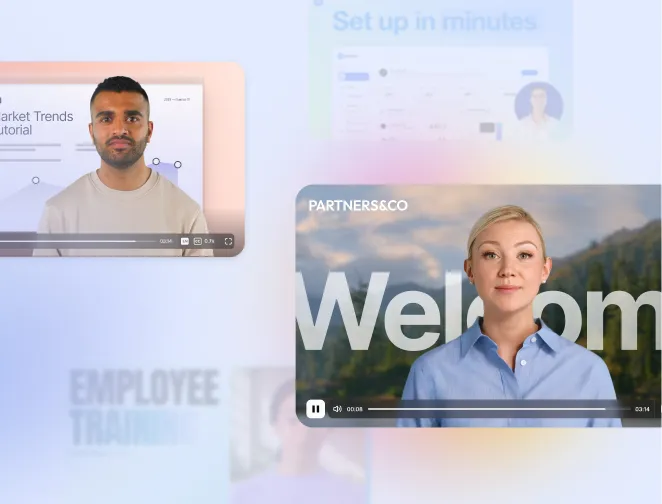
Create AI videos with 230+ avatars in 140+ languages.
The best L&D software by category:
- Best eLearning video authoring tool: Synthesia
- Best eLearning authoring tool: Rise 360
- Best learning management system (LMS): Cornerstone OnDemand
- Best online course provider: Coursera Business
- Best for knowledge sharing & collaboration: Notion
- Best micro-learning platform: Axonify
Types of learning and development platforms
Course authoring tools
Course authoring tools are software solutions that allow instructional designers and educators to create, customize, and publish eLearning content. These tools often include drag-and-drop functionality, pre-built templates, and multimedia integration to produce engaging and interactive training modules.
eLearning course authoring tools can be broadly categorized into two main subtypes: eLearning video authoring tools and eLearning authoring tools.
{{cta-section data-type="1" data-heading="Create Training Videos with Synthesia" data-body="Join over 1M+ users today and save time, reduce costs, and boost learner engagement with AI-powered videos in 140+ languages."}}
Learning management systems (LMSs)
Learning Management Systems (LMSs) are centralized platforms that manage the delivery, tracking, and reporting of training programs. They are used to host eLearning courses, assign training to learners, and monitor progress. LMSs are essential for organizations aiming to streamline training, onboarding, and professional development initiatives.
Online course providers
Online course providers offer ready-made training courses created by experts, catering to a wide range of skills and industries. Platforms like Coursera, Udemy, and LinkedIn Learning enable organizations and individuals to access high-quality, standardized training content without developing materials in-house, which can lead to significant L&D cost reductions.
Knowledge sharing and collaboration tools
Knowledge sharing and collaboration tools facilitate the exchange of expertise and ideas within teams or across an organization. These platforms encourage peer-to-peer learning through shared documents, discussions, and collaborative projects, promoting a culture of continuous learning.
Micro-learning platforms (MLPs)
Micro-learning platforms (MLPs) specialize in delivering bite-sized training content that is easily digestible and can be consumed on the go. These tools are perfect for addressing specific skills or knowledge gaps quickly, often via mobile-friendly formats like videos, flashcards, or short quizzes.
For more L&D tools you can check out our guide to the best employee training software.
The best L&D software by use case:
Best eLearning video authoring tool: Synthesia
Pros
- User-friendly: Simple, intuitive interface; no prior video production knowledge is needed
- Speed: Allows for the creation of professional-looking training videos in less than an hour
- Real-time collaboration: Facilitates real-time editing, reviewing, and feedback from team members
- Realistic AI avatars: A diverse library of realistic AI avatars with natural movements and expressions
- Broad language support: Supports over 140 languages, accents, and dialects
- Extensive customization: Offers branding options, adjustable backgrounds, text overlays, and animated elements
- Templates: Ready-to-use layouts for tutorials, explainer videos, and other formats save significant time
- SCORM export: Exports seamlessly integrate with most LMS platforms
- Scalability: Capable of producing large quantities of personalized videos efficiently
- AI screen recording: Integrates step-by-step walkthroughs directly into training videos with ease
Cons
- Limited animation options: Not designed for advanced animations or detailed motion graphics - you might need additional editing software for this
Pricing
Synthesia offers users a free plan and three paid plans starting at $29/month.
My experience with Synthesia
Synthesia has quickly become a go-to tool in my learning and development (L&D) workflow. It uses AI to generate eLearning courses with professional avatars and voiceovers.
As someone who creates training materials regularly, I’ve found that it bridges the gap between traditional course creation methods and the need for engaging, video-based learning. It’s been a perfect fit for the growing demand for scalable, localized, and visually compelling training content.
The process of creating videos with Synthesia is refreshingly simple. I usually start by picking a template that matches the content I’m working on—whether it’s a technical how-to or a soft skills session. From there, I add my script, select an AI avatar that feels appropriate for my audience, and customize the visuals to reflect our company’s branding.
In under an hour, I can go from concept to a polished, professional-quality video. Synthesia even has a built-in screen recording feature, which makes it easy to include step-by-step demonstrations directly in the video.
One feature that stands out is its localization capabilities. I can transform a single video into multiple languages without needing translators or voice actors. The AI avatars adjust seamlessly to different languages, accents, and dialects, with lip-syncing that looks impressively natural.
I also appreciate how customizable Synthesia is. I often tweak the backgrounds, add text overlays, and incorporate our company’s logos to make the videos feel tailored and professional.
Once the video is ready, I typically export it as a SCORM package, which integrates smoothly into our LMS. This makes tracking learner progress and collecting feedback incredibly straightforward.
Another highlight is the real-time collaboration feature. My team can easily review, comment, and edit videos together, ensuring the final product meets everyone’s standards. It’s a small detail that makes a big difference in creating high-quality training materials.
Alternative: Camtasia
Camtasia is a reliable tool for creating screen-recording-based training videos, with a straightforward recording feature that makes it easy to capture workflows. The ability to highlight mouse clicks and keystrokes is particularly useful for software tutorials.
The ability to add interactive elements, like quizzes, is another nice touch for boosting engagement. That said, the setup for these features can be a bit cumbersome and could use some streamlining. On the plus side, Camtasia offers options for branding, such as adding logos and customizing color schemes, which helps ensure a consistent look and feel across all my projects.
One downside, though, is the lack of real-time collaboration. It can make working as a team on video projects more challenging than it needs to be, especially when multiple edits or reviews are required.
Camtasia provides three subscription plans on an annual basis starting at $179.88/year, which includes fundamental recording and editing tools. They also offer a 7-day free trial.
Best eLearning authoring tool: Rise 360
Pros
- Ease of use: The drag-and-drop editor and pre-designed templates make course development straightforward, even for those new to the platform
- Responsive design: Automatically resizes to fit different screen dimensions, removing the hassle of manual resizing
- Collaboration-friendly: Enables multiple contributors to edit a project simultaneously and simplifies feedback using Articulate Review 360
- Interactivity options: Comes equipped with built-in features like quizzes, timelines, labeled graphics, and process diagrams to create interactive content
- Microlearning support: The modular design works well for producing concise, targeted lessons
- LMS compatibility: Compatible with SCORM, xAPI, and AICC standards for smooth learning management system connectivity
- Web Hosting option: Provides the option to host courses directly on the web without requiring an LMS
Cons
- Subscription-based: Access is bundled with the Articulate 360 suite, which might not be budget-friendly for small teams
- Interactivity constraints: Offers fewer options for deep interactivity compared to tools like Storyline 360 or Adobe Captivate
- Dependent on pre-set templates: Courses must conform to predefined template structures, potentially stifling creativity
Pricing
Rise 360 is available as part of the Articulate 360 subscription, which starts at $1,199 per year per user. The subscription includes all Articulate tools, but Rise 360 cannot be purchased separately. You can get a free 30-day trial of Articulate 360.
My experience with Rise 360
Articulate Rise 360, part of the Articulate 360 suite, is my go-to tool for quickly developing responsive eLearning courses. I’ve used it extensively for corporate training projects, and its user-friendly interface, pre-built templates, and automatic responsiveness make it a fantastic option, especially for teams without a lot of technical expertise.
One thing I love about Rise 360 is how easy it is to use. I've created an onboarding course in just a few hours using its drag-and-drop editor and ready-made components like timelines and tabs. It let me focus on the content instead of getting bogged down in the design—a huge plus when deadlines are tight or when working with less experienced team members.
The built-in responsive design is another major win. I recently worked on a mobile-first compliance training project and tested the courses on different devices. They looked flawless on every screen size without requiring any additional adjustments. This is a huge advantage over more design-intensive tools like Storyline 360.
Rise 360 also offers plenty of interactive elements, like quizzes, labeled graphics, and process diagrams, which do a great job of keeping learners engaged. While the interactivity options are usually enough for most projects, they don’t offer the same level of customization as tools like Storyline 360 or Adobe Captivate.
Rise 360 also excels in collaboration. During a global sales training project, my team could work on different sections of the course at the same time. Gathering feedback from stakeholders using Articulate Review 360 was straightforward and streamlined, making the whole process much more efficient.
Exporting courses is simple too. Rise 360 supports SCORM, xAPI, and AICC formats, so it integrates easily with any LMS. I’ve used SCORM exports with Moodle many times without any issues, and it’s also handy for hosting courses on the web.
Rise 360 is an excellent tool for microlearning, with its modular format making it easy to create short, focused lessons. I used it to create 10-minute modules for a product knowledge campaign, which worked perfectly for busy sales reps who needed quick, digestible training.
Alternative: iSpring Suite
iSpring Suite is a straightforward and user-friendly eLearning tool that works as a PowerPoint add-in, making it perfect for creating courses quickly. I’ve often used it to turn existing PowerPoint decks into SCORM-compliant courses by adding quizzes, voice narrations, and branching scenarios. It’s been a huge time-saver while still delivering professional-quality results. The timeline editor and screen recording tool are particularly helpful for syncing voiceovers and creating clear software demos.
While it doesn’t offer advanced collaboration features or true responsive design, iSpring is all about speed and efficiency. It’s an excellent choice for time-sensitive projects, especially when you’re repurposing existing content.
Pricing starts at $770 per year for the basic iSpring Suite. If you need access to their content library and real-time collaboration features, the iSpring Suite Max option is $970 per year. They also offer a premium plan for $1,970 per year. For anyone on the fence, there’s a 14-day free trial to explore its features.
Best learning management system (LMS): Cornerstone OnDemand
Pros
- Widely used and reliable: Cornerstone is a trusted platform used by many organizations across industries
- Comprehensive features: Combines learning, performance, and talent management in one system
- Highly customizable: Offers extensive options to tailor learning paths, reports, and user roles—once you get familiar with the system
- Integration capabilities: Seamlessly integrates with HR systems, content providers, and third-party tools
- Content marketplace: Access to a variety of off-the-shelf courses to supplement custom training
- Mobile-responsive: Works well on various devices without additional effort
- Powerful reporting: Includes detailed analytics to track learner progress and engagement
Cons
- Steep learning curve: Administrators may find the platform overwhelming due to its complexity
- Performance issues: Slow load times and glitches, especially with large datasets, can impact efficiency
- Customer support concerns: Responses for complex issues can be slow and less effective than expected
- Cost: Often expensive, potentially out of reach for smaller organizations
Pricing
Cornerstone OnDemand's pricing is custom, so you'll need to schedule a demo to get a quote.
My experience with Cornerstone OnDemand
Cornerstone OnDemand is one of the most widely used Learning Management Systems for a reason. It’s incredibly robust and offers deep customization options once you’re comfortable with its interface. However, its complexity means there’s a significant learning curve, especially for administrators.
In one of my first experiences with the platform, I implemented Cornerstone for a global onboarding program. The ability to customize learning paths based on job roles allowed us to deliver targeted training efficiently—for example, customer-facing roles received sales-focused modules while technical staff were assigned product certifications. The system’s scalability was a huge asset for managing our diverse workforce.
That said, it wasn’t all smooth sailing. Setting up the platform was challenging, with a lot of trial and error involved in configuring workflows, permissions, and integrations. I spent significant time learning the reporting tools, but once I got the hang of it, the insights were invaluable. I used the analytics features to track completion rates and identify gaps while working on a compliance training initiative, which helped ensure we met regulatory deadlines.
On the learner side, feedback highlighted a less intuitive interface. Some employees found navigation cumbersome, and a few dropped off from courses due to confusion. As an admin, I also encountered performance issues—slow loading when running large reports and occasional glitches during peak usage hours.
Cornerstone’s content marketplace was a great asset during a recent leadership development project. We were able to supplement our custom modules with off-the-shelf courses on topics like emotional intelligence, which saved a lot of time and effort.
Customer support was another pain point. While they were helpful for simple questions, resolving complex technical issues often took longer than expected. For example, I once spent a week trying to fix an integration error with a client's HR system which delayed a training launch by a week.
Despite these challenges, Cornerstone’s powerful features and extensive customization options make it a worthwhile investment for organizations with the resources and expertise to manage it. For teams willing to invest time in mastering the platform, it can handle even the most complex learning and development needs effectively.
Alternative: Docebo
Docebo stands out as a modern and comprehensive LMS, offering a fresh alternative to traditional platforms. Its intuitive interface made it easy to navigate for both admins and learners during a test product training initiative I managed. The AI-driven content recommendations were a highlight, as they automatically suggested relevant courses tailored to individual user roles and learning behavior. This feature kept engagement high without requiring much manual effort on my part.
I also appreciated Docebo’s strong integration capabilities. For example, linking it with our CRM allowed us to track how training impacted sales performance, giving us measurable insights into the program’s success. The platform’s social learning tools, such as discussion boards and peer feedback, encouraged collaboration, which worked particularly well for team-based learning activities.
However, there were some challenges. Customizing the platform to meet specific needs sometimes required diving into custom CSS, which was time-consuming and required technical expertise. Another issue I encountered was with auto-enrollment for region-specific sessions, which required manual adjustments to avoid scheduling conflicts.
Despite these hurdles, Docebo’s modern interface, AI-powered personalization, and robust integration options made it a highly effective tool for delivering engaging and impactful training. It’s a great choice for organizations looking for a versatile and innovative LMS.
Docebo has 3 tiers: Engage, Elevant and Enterprise. Pricing is custom, so you'll need to contact their sales team to get a quote.
Best online course provider: Coursera Business
Pros
- High-quality content: Courses developed by top universities and industry leaders ensure credibility and depth
- Extensive course catalog: Covers a wide range of topics, from technical skills to leadership development
- Flexible learning: Employees can complete courses at their own pace, accommodating busy schedules
- Professional certifications: Offers certifications from institutions like Stanford and Google, adding value for employees
- Scalable for organizations: Works well for both small teams and global enterprises
- Mobile-friendly: Accessible on any device via the Coursera app
- Analytics and reporting: Provides detailed insights into learner progress and completion rates
- Global accessibility: Courses are available in multiple languages and designed for diverse learners
Cons
- Focus on individual learning: Limited team-based learning or collaborative features
- Cost: Subscriptions can add up for larger organizations or high-volume usage
- Completion rates: Some learners struggle to finish longer courses without strong incentives
Pricing
Coursera Business offers a Team plan for $399 per user/year which allows between 5 and 125 users. For more than 125 users, you'll need to use their Enterprise plan. Contact their sales team to get pricing.
My experience with Coursera Business
Coursera Business has been a fantastic addition to our corporate learning strategy, offering unparalleled access to high-quality, up-to-date courses from leading universities and companies. I recently used it for a company-wide upskilling initiative with a focus on data science and leadership development. The professional certifications from renowned institutions like Duke University and Google were a major draw for employees, boosting their engagement and motivation.
One of Coursera’s greatest strengths is its flexibility. Employees could learn at their own pace, which was especially beneficial for those juggling work and training. The mobile app made it even more convenient, allowing employees to fit learning into their daily routines, whether during commutes or at home.
The analytics and reporting tools were a valuable asset. I could easily track progress, identify who might need additional support, and measure the overall impact of the training. This data-driven approach helped us showcase the program’s success to stakeholders.
While Coursera excels at individual learning, it’s less focused on collaborative training. I was recently working on a team-building training project in which we decided to supplement the Coursera platform with internal workshops to encourage group discussions and practical application of what was learned. Additionally, while completion rates were generally high, longer courses occasionally required extra encouragement to keep employees on track.
Overall, Coursera Business is an excellent solution for delivering professional, scalable training to employees. Its extensive course catalog, flexibility, and certifications make it ideal for companies looking to empower their workforce with cutting-edge skills and knowledge.
Alternative: Udemy Business
Udemy Business has been a flexible and affordable solution for our corporate training needs. Its extensive library covers diverse topics, allowing employees to choose courses aligned with their goals. This self-directed approach boosted engagement during a recent upskilling initiative, where team members explored areas like Python programming and leadership development.
The platform’s accessibility was a highlight—employees could learn at their own pace, on any device, with bite-sized lectures that fit easily into their schedules. While course quality varied, I curated a list of recommended courses to ensure the best experience.
Udemy’s affordability and variety make it a valuable tool for scalable training. Though its reporting tools are basic, they were sufficient for tracking progress and encouraging completion. Overall, it’s a practical option for empowering employees with new skills.
Udemy Business offers a Team plan for $360 per user/year which allows between 2 and 20 users. For more than 20 users, you'll need to use their Enterprise plan - you can request a demo here to get pricing.
{{cta-section data-type="1" data-heading="Create Training Videos with Synthesia" data-body="Join over 1M+ users today and save time, reduce costs, and boost learner engagement with AI-powered videos in 140+ languages."}}
Best for knowledge sharing & collaboration: Notion
Pros
- Highly customizable: Offers flexible templates, databases, and workspaces that can be tailored to various workflows
- All-in-one workspace: Combines note-taking, project management, and knowledge sharing in a single platform
- Intuitive interface: User-friendly design makes it easy for teams to adopt and use effectively
- Real-time collaboration: Teams can collaborate on documents and projects in real-time
- Cross-platform access: Available on desktop, mobile, and web, ensuring accessibility
- Integration-friendly: Integrates with tools like Slack, Google Drive, and Trello to streamline workflows
- Search functionality: Advanced search makes it easy to locate documents and notes quickly
Cons
- Overwhelming for beginners: The vast customization options can be intimidating at first
- Offline functionality: Limited offline capabilities can disrupt workflows without internet access
- Performance issues: Occasionally sluggish with large databases or heavy content
- Limited advanced features: Lacks robust automation compared to dedicated project management tools
- Pricing for teams: Costs can add up for larger teams using premium features
Pricing
Notion offers a Free plan, Plus at $10 per user/month, Business at $15 per user/month, and Enterprise with custom pricing. Notion AI is available for an extra $8–$10 per user/month.
My experience with Notion
Notion has been a game-changer for organizing and sharing knowledge within my team. Its all-in-one design allowed us to centralize notes, project plans, and resources in one easily accessible workspace. We also tailored templates and databases to fit specific workflows, such as task tracking and meeting agendas. While the flexibility is fantastic, it took some time to set up initially, as the endless options can be overwhelming for new users.
Real-time collaboration was another highlight - team members can update documents simultaneously, ensuring everyone stays aligned. The integration with Slack also help us receive updates directly in our communication channels.
However, there were a few challenges. When working with large databases, I noticed occasional lag, and the limited offline functionality was frustrating during travel or in low-connectivity areas. Despite these minor drawbacks, the ability to access Notion across devices made it easy to stay organized.
Overall, Notion’s versatility and collaborative features make it an excellent tool for knowledge sharing and project management. While it requires a bit of a learning curve to unlock its full potential, it’s a powerful platform for teams looking to centralize their workflows and boost productivity.
Alternative: Guru
Guru has been an incredibly effective tool for streamlining knowledge sharing within our team. Its card-based system allowed us to create and organize bite-sized pieces of information, which made accessing and updating key details seamless. During a recent onboarding initiative, Guru played a pivotal role by housing FAQs, process documentation, and best practices in a centralized and easily searchable format.
What stood out the most was Guru’s integration with tools we already use, like Slack and Google Workspace. Team members could access relevant information directly within their workflow, reducing interruptions and speeding up decision-making. The real-time verification feature also ensured that our knowledge base stayed up-to-date, which was invaluable for maintaining accuracy in fast-changing projects.
The ease of use was a big plus. Adding and updating content felt intuitive, and the browser extension was particularly handy for quick access to knowledge without switching tabs. However, for larger teams, organizing cards into collections required some upfront planning to ensure everything remained logically structured.
While Guru excels at sharing knowledge, it’s not as robust for complex workflows or project management. We supplemented it with other tools to handle task tracking and collaboration.
Overall, Guru is an excellent tool for capturing, organizing, and sharing knowledge across teams. It’s particularly useful for onboarding, support, and ensuring critical information is always at your team’s fingertips.
Guru offers a free trial for 30 days. After that, the All-in-one plan is $15 per user/month, with volume discounts available. The Enterprise plan is custom-priced, offering additional features like priority support and dedicated onboarding.
Best micro-learning platform: Axonify
Pros
- Focused on microlearning: Designed specifically for bite-sized, engaging training sessions
- Personalized learning paths: Uses AI to adapt training content to individual learners’ needs
- Gamification features: Includes points, badges, and leaderboards to boost learner motivation
- Knowledge reinforcement: Delivers regular quizzes to help employees retain information over time
- Mobile-friendly: Fully accessible on mobile devices, ideal for on-the-go learners
- Performance insights: Provides detailed analytics to track learning progress and its impact on job performance
- Integration options: Connects with existing LMS and HR platforms for seamless data sharing
Cons
- Limited depth: May not be suitable for more comprehensive or in-depth training programs
- Initial setup effort: Customizing content and integrating with other systems can take time
- Gamification overload: Some learners may find gamified elements distracting or less engaging
- Cost: Pricing can be a barrier for smaller organizations or teams with limited budgets
Pricing
Axonify offers custom pricing for its solutions based on business needs and the number of users. Pricing details are available upon request.
My experience with Axonify
Axonify has been a valuable tool for delivering quick, targeted training that fits into the flow of work. I used it during a retail training initiative to ensure employees could easily grasp key product knowledge and customer service skills. The platform’s microlearning approach was perfect for the busy schedules of frontline workers, allowing them to complete training in just a few minutes each day.
One of Axonify’s best features is its personalized learning paths. Employees received daily quizzes and training modules tailored to their knowledge gaps, which kept the content relevant and engaging. The gamification elements, like leaderboards and rewards, added a layer of friendly competition that motivated participation and boosted completion rates.
The platform’s mobile accessibility was another big win. Employees could access training on their phones during breaks or commutes, which improved participation rates significantly. The knowledge reinforcement feature also impressed me—it regularly revisited key concepts to help learners retain information over time, which was crucial for compliance-related training.
Overall, Axonify is a fantastic platform for delivering quick, impactful training tailored to individual learners. Its microlearning approach, gamification features, and mobile accessibility make it a powerful tool for improving employee performance, particularly in roles that require ongoing reinforcement of key knowledge.
Alternative: EdApp/SC Training
EdApp (now called SC Training) has been an exceptional tool for creating and delivering engaging microlearning courses. I used it during a compliance training initiative, and its user-friendly interface made it easy to design bite-sized, interactive modules that fit seamlessly into employees’ busy schedules. The pre-built templates and drag-and-drop editor helped us launch training quickly without compromising on quality.
One of my favourite features is EdApp’s gamification options. By incorporating elements like quizzes, leaderboards, and rewards, we were able to significantly increase learner engagement and participation rates. Employees particularly appreciated the points system, which added a fun, competitive element to the training.
EdApp’s mobile-first design comes in handy as it enables employees to complete training on their phones during downtime. The offline mode also allowed access to courses without a stable internet connection, which can prove valuable for some employees.
The built-in analytics provided insights into learner progress and completion rates, allowing us to identify knowledge gaps and adjust content as needed. For example, when a quiz revealed that a particular compliance topic was challenging, we added extra reinforcement materials to ensure better understanding.
While EdApp offers many integrations, be warned that setting up some advanced workflows required significant extra time and technical expertise.
Overall, EdApp is a powerful microlearning platform that combines ease of use, engaging features, and mobile accessibility. It’s an excellent choice for organizations looking to deliver quick, impactful training to a diverse workforce.
SC Training offers a Free plan for up to 10 learners, including unlimited shareable courses and AI-generated lessons. The Premium plan costs $60 a year per learning, with additional features like advanced analytics, AI translation, and secure access. The Enterprise plan is custom-priced for 500+ users, offering tailored support, onboarding, and advanced features. Book a demo here.
About the author
Strategic Advisor
Kevin Alster
Kevin Alster is a Strategic Advisor at Synthesia, where he helps global enterprises apply generative AI to improve learning, communication, and organizational performance. His work focuses on translating emerging technology into practical business solutions that scale.He brings over a decade of experience in education, learning design, and media innovation, having developed enterprise programs for organizations such as General Assembly, The School of The New York Times, and Sotheby’s Institute of Art. Kevin combines creative thinking with structured problem-solving to help companies build the capabilities they need to adapt and grow.

Frequently asked questions
What are the key features to look for in a learning and development tool?
Look for features that align with your team’s needs, such as ease of use, mobile accessibility, robust analytics, integration with other systems, and support for personalized or microlearning approaches. Tools with gamification and collaboration capabilities can also boost engagement.
How do I choose the right tool for my organization?
Start by identifying your organization’s training goals, workforce size, and budget. Evaluate tools based on their scalability, content offerings, user feedback, and compatibility with existing systems like your LMS or HR platform. Consider trial periods to test their usability and effectiveness.
What is the difference between microlearning platforms and traditional LMS tools?
Microlearning platforms focus on delivering short, targeted training sessions that fit into employees’ daily workflows. Traditional LMS tools are more comprehensive, offering in-depth course management, certifications, and detailed reporting. Both serve different needs and can complement each other.
Can these tools be used for remote and hybrid teams?
Yes, most modern L&D tools are designed with remote and hybrid teams in mind. They offer mobile apps, cloud-based access, and real-time collaboration features to ensure training is accessible and engaging, regardless of location.
Are these tools suitable for small businesses or only for large enterprises?
Many tools cater to both small businesses and large enterprises, with different pricing plans for each case.














